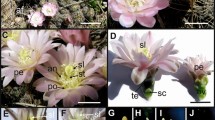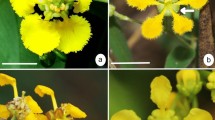Abstract
Sex distribution in a neotropical willow,Salix martiana Leybold, has long escaped the attention of botanists. Its catkins are regularly composed of female, hermaphrodite and male flowers. The present paper discusses some aspects of its possible morphological and/or evolutionary significance.
Similar content being viewed by others
References
Andersson, N. J., 1867: MonographiaSalicum. — Stockholm: P. A. Norstedt et filii.
Baker, H. G., 1955: Self-compatibility and establishment after “long-distance” dispersal. — Evolution9, 347–349.
Fisher, M. J., 1928: The morphology and anatomy of the flowers of theSalicaceae I, II. — Amer. J. Bot.15, 305–326, 372–394.
Hjelmqvist, H., 1948: Studies in the floral morphology and phylogeny of theAmentiferae. — Bot. Notiser, Suppl.2, 147–166.
Leybold, F., 1855:Salicineae. — In:Martius, C. F. P. von: Flora Brasiliensis4 (1), 225–228. — München, Wien, Leipzig: C. Wolf et filii.
Velenovský, J., 1904: Vergleichende Studien über dieSalix-Blüte. — Beih. Bot. Centralbl.17, 123–128.
Author information
Authors and Affiliations
Rights and permissions
About this article
Cite this article
Rohwer, J., Kubitzki, K. Salix martiana, a regularly hermaphrodite willow. Pl Syst Evol 144, 99–101 (1984). https://doi.org/10.1007/BF00986668
Received:
Issue Date:
DOI: https://doi.org/10.1007/BF00986668




